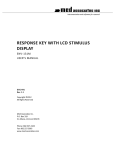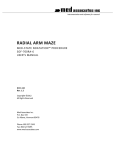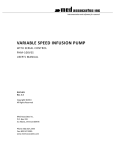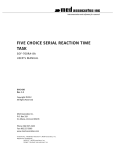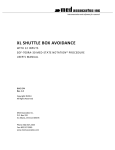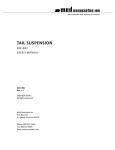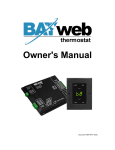Download BBE Sound 262 User`s manual
Transcript
ANL-940-1 ULTRASONIC MICROPHONE AND AMPLIFIER USER’S MANUAL DOC-262 ANL-940-1 USER’S MANUAL Rev. 1.0 Copyright © 2012 All Rights Reserved MED Associates, Inc. P.O. Box 319 St. Albans, Vermont 05478 www.med-associates.com MED ASSOCIATES INC. A N L - 9 4 0 - 1 U L T R ASO NI C M I C R O P H O NE A ND AM P L I FI E R THIS PAGE INTENTIONALLY LEFT BLANK i MED ASSOCIATES INC. A N L - 9 4 0 - 1 U L T R ASO NI C M I C R O P H O NE A ND AM P L I FI E R Table of Contents Chapter 1 ....................................................................................................................... 1 Overview ............................................................................................................................................. 1 Specifications .................................................................................................................................. 1 Notes ................................................................................................................................................ 1 Requirements .................................................................................................................................. 1 Chapter 2 ....................................................................................................................... 2 Hardware ............................................................................................................................................. 2 Chapter 3 ....................................................................................................................... 3 Operation ............................................................................................................................................ 3 Appendix A ..................................................................................................................... 6 Quantitative Analysis of Sound Pressure Levels ............................................................................... 6 Appendix B ..................................................................................................................... 9 Contact Information ........................................................................................................................... 9 ii MED ASSOCIATES INC. A N L - 9 4 0 - 1 U L T R ASO NI C M I C R O P H O NE A ND AM P L I FI E R CHAPTER 1 Overview The ANL-940-1 Ultrasonic Microphone and Amplifier accurately measures both the amplitude and frequency of ultrasonic vocalizations emitted by laboratory rodents . This device is suitable for measuring motivational behavior in drug addiction studies, mother -pup separation, isolation stress, social interactions, sexual encounters, and many other paradigms . The instrument produces an analog voltage output (BNC Connector) that is proportional to sound pressure level. The analog output can be connected to third party data acquisition systems. (e.g. National Instruments) Specifications The frequency response of the ANL-940-1 is linear (+/- 4 dB) up to 100 kHz. The analog output is +\- 14 Volts. The ANL-940-1 microphone and preamplifier combination are calibrated to provide 1 volt peak output into a high impedance load when excited with a 50 kHz ultrasound sine wave with a peak pressure level of 1 Pa, or L p = +94 dB SPL (20 µPa = 0 dB). Peak levels were selected for ease of setting up associated A to-D converters, as the peak value could be easily related to the full -scale count of the converter. This calibration is independent of distance from the sound source and reflects the actual sound pressure at the face of the microphone. The output impedance of the ANL-940-1 amplifier is 50 Ohms and must be considered when connecting the unit to other measurement equipment. Notes 1. The high impedance load assumed for calibration is high relative to 50 Ohms and the loading effect of low impedances must be considered. For example, 500 Ohm load has an error of less than 1 dB, while a 10000 Ohm load has an error of less than 0.05 dB. 2. If the A-to-D has 50 Ohm load, the sensitivity is reduced to 0.5 V peak due to the drop across the ANL-940-1 internal impedance. Many instruments have a fixed 50 Ohm input impedance, so the input impedance of your recording hardware should be determined if your goal is to make quantitative measurements of vocalization amplitudes (in dB). Requir ements - Third party data collection hardware and software -1DOC-262 Rev 1.0 Copyright © 2012 MED Associates, Inc. MED ASSOCIATES INC. A N L - 9 4 0 - 1 U L T R ASO NI C M I C R O P H O NE A ND AM P L I FI E R CHAPTER 2 Hardware The ANL-940-1 includes a Microphone and an Amplifier. A power supply is also included, which provides a minimum of 12V, 500mA. The brand and type of power supply depends on the user’s country . The ANL-940-1 Ultrasonic Microphone (Figure 2.1) is designed for sound waves in the 500Hz to 100KHz range. Figure 2.1 – ANL-940-1 Microphone with Exploded Views of Connector and Microphone The amplifier on the ANL-940-1 is calibrated to provide a relatively flat frequency response for the microphone (+/-4 dB from 500 Hz through 100KHz). It uses a 12V 500mA DC power and outputs the signal to a BNC port. Figure 2.2 – ANL-940-1 Microphone Amplifier -2DOC-262 Rev 1.0 Copyright © 2012 MED Associates, Inc. MED ASSOCIATES INC. A N L - 9 4 0 - 1 U L T R ASO NI C M I C R O P H O NE A ND AM P L I FI E R CHAPTER 3 Operation Two output settings are available ‘DIRECT’ and ‘LPF’ . LPF applies a low-pass filter to the output signal with a cutoff frequency of 100 KHz for use as an anti -aliasing filter. The front panel has an access for the calibration screw marked ‘CAL.’ This calibration screw adjusts the overall gain of the amplifier . The ANL940-1 has been pre-calibrated at the factory. Do not adjust the instrument gain if you will be using the ANL-940-1 to quantify the actual amplitude (dB) of rodent vocalization. Refer to Appendix A for more information regarding measurement of sound pressure level amplitud es. 1. Place the microphone over the chamber The microphone should be centered over desired location, and pointing at the subject of interest. The picture in Figure 3.1 shows a typical setup for mouse open field ultrasonic vocalization. Figure 3.1 – Microphone Placed Over Cage (Microphone Support Not Included) -3DOC-262 Rev 1.0 Copyright © 2012 MED Associates, Inc. MED ASSOCIATES INC. A N L - 9 4 0 - 1 U L T R ASO NI C M I C R O P H O NE A ND AM P L I FI E R 2. Attach microphone to amplifier The microphone jack is ‘keyed’ and only fits one way . Rotate until it slides in. Screw the outer sleeve to the jack to prevent accidental disconnection. Figure 3.2 – Microphone Connected to Amplifier 3. Connect amplifier to Data Acquisition Device (DAQ) using BNC cable Med Associates, Inc. recommends using a National Instruments DAQ device, such as the myDAQ or ELVIS. The ANL-940-1 has been tested with this equipment. For connection from the ANL-940-1 BNC connector to the National Instruments DAQ device, the center and ground can be screwed into the terminals. Alternately, Med Associates makes an ANL-940-DA-1 BNC adapter for the myDAQ to interface with a National Instruments myDAQ device.. Figure 3.3 –Connect National Instruments myDAQ (shown with BNC Adapter) to ANL-940-1 NI myDAQ ANL-940-1 ANL-940-DA-1 BNC Adapter -4DOC-262 Rev 1.0 Copyright © 2012 MED Associates, Inc. MED ASSOCIATES INC. A N L - 9 4 0 - 1 U L T R ASO NI C M I C R O P H O NE A ND AM P L I FI E R 4. Plug in power supply and turn on amplifier The power supply has a 2.1mm connector and supplies 12V, 500mA . Insert the connector into the port on the back of the Amplifier and flip on the power switch. Figure 3.4 - Back View of ANL-940-1 Microphone Amplifier Insert power supply connector to Power Input port 5. Select “LPF” or “Direct” “Direct” passes the microphone input directly to the DAQ . “LPF” applies a low-pass filter to the signal. The LPF is an anti-aliasing filter that attenuates signals above 100KHz . The “LPF” setting is recommended. Figure 3.5 – Location of Direct/LPF Switch Direct/LPF Switch -5DOC-262 Rev 1.0 Copyright © 2012 MED Associates, Inc. MED ASSOCIATES INC. A N L - 9 4 0 - 1 U L T R ASO NI C M I C R O P H O NE A ND AM P L I FI E R Appendix A Quantitative Analysis o f Sound Pressure Levels Unlike many instruments on the market, the ANL -940-1 Ultrasonic Microphone and Amplifier is a specialized device that is calibrated to produce a defined signal amplitude in response to a standard sound pressure level. Thus, it is useful not only for recording the frequency profile of rodent vocalizations, but also it can provide an accurate measure of the amplitude, or Sound Pressure Level, of the vocalizations. For researchers interested in quantifying the amplitude of vocalizatio ns, special consideration should be given to the calibration specifications of the ANL -940-1 instrument, as well as the physical layout of the recording environment, particularly the distance between the microphone and the test subject. To report standard Sound Pressure Levels (Lp), the level should be reported at a distance of 1 meter between the microphone and test subject. However, it is often inconvenient to configure an arrangement in the lab where the microphone is at a distance of 1 meter from the t est subject. Thus, it is necessary to convert measurements obtained a distance of less than one meter to the equivalent measure that would be obtained at a distance of 1 meter. Calculating the 1 meter equivalent sound pressure level depends on the express ion of the initial measurement. If the microphone output is recorded as a voltage, the voltage expected at a distance of one-meter is obtained by multiplying the measured voltage by the measurement distance in meters. Example: If a microphone placed 0.25 m (or 1/4 m) from the source produces a sound pressure level of 30 mV (0.03V), the equivalent pressure at 1 m would be 30 mV * 0.25 = 7.5 mV ( or 30mV / 4). Recall that the ANL-940-1 has a calibration scaling of 1 Pa/V. Thus, the equivalent sound pressure level at 1 m would be 0.0075 V * 1 Pa/V = 0.0075 Pa. Considering the large variation of sound pressure levels typically encountered and the need to multiply or divide to obtain sound pressure in Pa at one-meter, it is usually easier to calculate sound pressure 1 using logarithms. A standard system has been developed (ANSI S1.1 -1994) to yield a logarithmic measure of the effective sound pressure level of one sound relative to a reference value. Thus, effective sound pressure levels are measured in decibels (dB) above a standard reference value. Sound Pressure Level (SPL), or sound level (L p ), is defined in ANSI S1.1-1994 as 1 Where p ref is a sound pressure level reference value, and p rms is the root mean squared (rms) value of the sound pressure level for the measured signal. -6DOC-262 Rev 1.0 Copyright © 2012 MED Associates, Inc. MED ASSOCIATES INC. A N L - 9 4 0 - 1 U L T R ASO NI C M I C R O P H O NE A ND AM P L I FI E R NOTE: Sound Pressure Level is often abbreviated simply as SPL. Sometimes variants of the actual measurement unit are used, such as dB (SPL), dBSPL, or dB SPL . These variants are not recognized as units in the ANSI standard. The unit dB (SPL) is sometimes abbre viated to just "dB", which can give the erroneous impression that a dB is an absolute unit by itself. Keep in mind that SPL measures (L p ) are not absolute measures in and of themselves. They are expressing one sound pressure relative to a reference sound pressure. The commonly used reference sound pressure level ( p ref ) in air is 20 µPa (rms), which is usually 1 considered the threshold of human hearing (roughly the sound of a mosquito flying 3 m away) . Most sound pressure level measurements will be made relative to this level, meaning 1 Pa will equal a SPL of 94 dB (20 log(1 Pa/0.00002 Pa) = 94 dB). If a sound pressure p 1 , is measured at a distance r 1 , one can calculate the sound pressure p 2 at another position r 2 using the following equation: Converting the resulting pressure to Sound Pressure Level (in dB) allows the correction for distance to be accomplished by simply adding logarithms. 20 log(p 2 ) = 20 log(p 1 *r 1 /r 2 ) = 20 log(p 1 ) + 20 log(r 1 ) - 20 log(r 2 ) In the case where r 2 = 1 meter, L p @1 meter = L p @r 1 + 20 log(r 1 ) Figure A.1 - Graph of 20 log(r 1 ) for distances less than 1 meter -7DOC-262 Rev 1.0 Copyright © 2012 MED Associates, Inc. MED ASSOCIATES INC. A N L - 9 4 0 - 1 U L T R ASO NI C M I C R O P H O NE A ND AM P L I FI E R Figure A.1 shows a plot illustrating the correction factor (in dB) that should be subtracted from SPL measurements taken at distances less than 1 meter to scale them to the equivalent SPL that would be obtained at 1 meter. Some commonly used measurement distances are indicated. To obtain the correction factor for any distance less than one meter, simply take the logarithm of the distance and multiply by 20. Subtract this value from the SPL you measured and this will give you the equivalent SPL at 1 meter. It is convention to express SPL measurement s at a distance of 1 meter. However, always be sure to state the distance used in your measurements when publishing papers. This will aid other readers in interpreting your data, and represents good scientific practice. Example: Setting up to make measurements that reflect expected pressure levels at one -meter. 1. Determine the distance from the sound source to the microphone, e.g., 0.25 meters. 2. If possible, set the A-to-D converter gain such that the largest expected analog signal provides a digital output slightly smaller than the maximum converter output count. 3. If possible, adjust the scaling factor of the display software such that the peak value of a 1 volt 50 kHz sine-wave input produces a reading of 94 dB + 20 log(distance) which for a distance of 0.25 m yields 94 dB + 20 log(0.25 m) = 94 dB – 12 dB = 82 dB The above scaling may be accomplished by either using the known gain factor for the A -to-D converter and the display software, or by applying a 1 volt peak (0.707 V rms) 50 kHz signal to the con verter input using a signal generator. The test generator output level may be determined either by direct measurement, or, if the generator provides a calibrated output, by using the set value directly. If it is not possible to scale your A-to-D recording hardware and software, you will need to do post hoc scaling of your recording signals using some other data processing method (e.g. export data from your recording system to an Excel spreadsheet). NOTE: if the signal generator output is set using the generator's output level control, be sure to load the generator output with the proper load. For example, if the generator output impedance is 50 Ohms, the output must be loaded with 50 Ohms. In the case where the A -to-D being used has a high input impedance, the stated generator output voltage must be doubled (i.e., a setting of 0.5 V peak will produce a 1 V peak signal into a high impedance load). Finally, if a test signal of 1 V peak causes the output of the A-to-D to saturate, reduce the amplitude of the test signal by a factor of ten to 0.1 V peak and replace the factor of +94 dB with +74 to compensate for the reduced signal level. A note on rms values Expressing signal levels in rms equivalent values assumes an averaging over either time or space, an d is usually used to express the spread of a measurement. The rms value of a single measurement is the measured value. In the case of a pure sine-wave, the measurement is assumed to be averaged over a full cycle and is typically used to calculate the pow er of the signal. For example, a sine-wave with an -8DOC-262 Rev 1.0 Copyright © 2012 MED Associates, Inc. MED ASSOCIATES INC. A N L - 9 4 0 - 1 U L T R ASO NI C M I C R O P H O NE A ND AM P L I FI E R amplitude of 1 V peak measured across a 1 Ohm resistor will cause 0.707 Watts to be dissipated in the resistor, as the rms voltage of a 1 V peak sine-wave is 0.707 V. For more complex signals, such as a rodent vocalization, the rms value must be computed by averaging the square of the vocalization over a selected duration, and then taking the square-root of the result, if indeed the energy put into the vocalization is of interest. References: 1 http://en.wikipedia.org/wiki/Sound_pressure#Sound_pressure_level Appendix B Contact Information Please contact MED Associates, Inc. for information regarding any of our products. Visit our website at www.med-associates.com for contact information. For technical questions, email [email protected]. -9DOC-262 Rev 1.0 Copyright © 2012 MED Associates, Inc.












